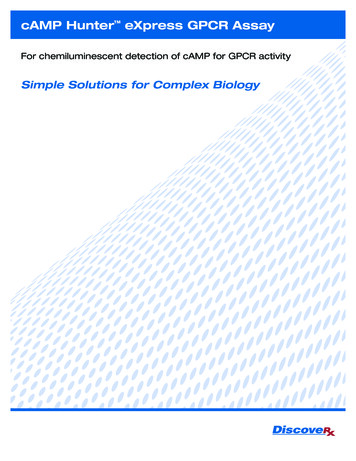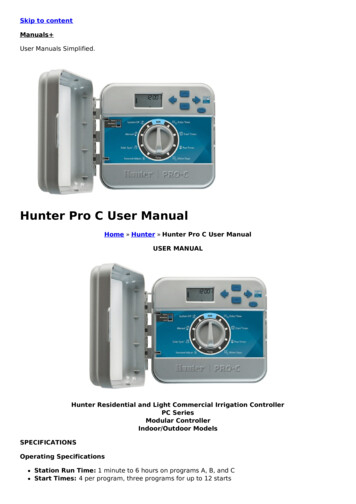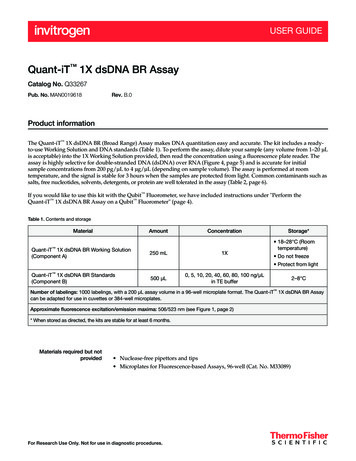
Transcription
cAMP Hunter eXpress GPCR AssayFor chemiluminescent detection of cAMP for GPCR activitySimple Solutions for Complex Biology
Table of ContentsOverview. 1Technology Principle . 1Intended Use. 2Materials Provided and Storage Conditions. 3Additional Materials. 3Protocol Schematic . 5Quick Start Procedure. 5Detailed Protocol (Agonist, 96-well, Gas). 6Step 1: Cell Preparation. 6Step 2: Assay Plate Preparation. 7Step 3: cAMP Standard Preparation. 7Step 4: Agonist Preparation. 8Step 5: Antibody and Working Solution Addition. 9Step 6: Enzyme Acceptor Addition. 9Step 7: Assay Plate Reading. 9Typical Results. 10Appendix. 11Antagonist Protocol for Gas-Coupled Receptors. 11Protocol for Gai-Coupled Receptors . 12PAMs and NAMs .13High Throughput Screening . 13Crude Biologic Samples . 13Adjusted Volumes for 384-well Format. 13FAQs. 14Limited Use License Agreement. 15Please read entire booklet before proceeding with the assay.For additional information or Technical Support, contact info@discoverx.comor visit www.discoverx.com. 2015 DiscoveRx Corporation. All Rights Reserved.DiscoveRx logo and DiscoveRx are registered trademarks of DiscoveRx Corporation. 20370 041615US: tel 1.866.448.4864e info@discoverx.comEU: tel 44.121.260.6142e euroinfo@discoverx.comwww.discoverx.com
cAMP Hunter eXpress GPCR Assay User ManualOverviewThe cAMP Hunter eXpress GPCR Assay can be used for small or large molecules. The kits provide a robust, highlysensitive and easy-to-use assay for monitoring G-protein coupled receptor (GPCR) activation based on 3'-5'-cyclicadenosine monophosphate (cAMP) production in cells.Technology PrincipleGPCR activation following ligand binding initiates aseries of second messenger cascades that result in acellular response. The signaling involves a membranebound enzyme called adenylate cyclase. Gai- and Gascoupled receptors modulate cAMP by either inhibitingor stimulating adenylate cyclase, respectively. With thecAMP Hunter eXpress GPCR Assay, cells over expressingGPCRs utilize the natural coupling status of the GPCRto monitor activation of Gai- and Gas-coupled receptors.Following ligand stimulation, the functional status ofthe GPCR is monitored by measuring the cellular cAMPlevels using a homogeneous (no wash), gain-of-signalcompetitive immunoassay based on Enzyme FragmentComplementation (EFC) technology.GPCR cAMP he cAMP Hunter eXpress GPCR Assay EFC technology uses a b-galactosidase (b-gal) enzyme split into twofragments, the Enzyme Donor (ED) and Enzyme Acceptor (EA). Independently these fragments have no β-gal activity;however, in solution they rapidly complement to form an active b-gal enzyme.In this assay, cAMP from cells and ED-labeled cAMP (ED-cAMP) compete for anti-cAMP antibody (Ab) binding sites.Antibody-bound ED-cAMP will not be able to complement with EA, but unbound ED-cAMP is free to complement EAto form active enzyme, which subsequently produces a luminescent signal. The amount of signal produced is directlyproportional to the amount of cAMP in the cells.Low Levels of Cellular cAMPCellular cAMPAnti-cAMP AbED-cAMPEAHigh Levels of Cellular cAMPSubstrateHydrolysisCellular cAMPUS: tel 1.866.448.4864Anti-cAMP AbED-cAMPe info@discoverx.comEU: tel 44.121.260.6142Active EFCEnzymee euroinfo@discoverx.comwww.discoverx.comLight1
cAMP Hunter eXpress GPCR Assay User ManualIntended UseThe cAMP Hunter eXpress GPCR Assay kits provide a robust, highly sensitive and easy-to-use, cell-based functionalassay to study GPCR activity through cAMP production. The pre-validated, frozen eXpress cells have beenmanufactured for short term use and are provided in a convenient, ready-to-screen format that saves time and addsconvenience. The kits contain all the reagents needed for the detection of cAMP from eXpress cells expressing Gαi- andGαs-coupled receptors induced with a small or large molecule ligand. This flexible assay system has been designed towork in agonist or antagonist mode for 96- and 384-well plate formats. After plating and stimulation of cells, the usersimply adds the assay reagents to the cells following the homogeneous, easy-to-use protocol provided.cAMP Hunter eXpress GPCR Assay Schematic ProtocolPlate CellsAssayBufferWorkingED-cAMP SolutionLigandIncubateUS: tel 1.866.448.4864e info@discoverx.comcAMPAntibodySolutionIncubateEU: tel 44.121.260.6142EARead signalIncubatee euroinfo@discoverx.comwww.discoverx.com2
cAMP Hunter eXpress GPCR Assay User ManualMaterials Provided and Storage ConditionsList of ComponentsCell ComponentsNumber of cellsStoragecAMP Hunter eXpress Cells 1 vial2 vials10 vialsNumber of Cells3.75 x 106cells eachvial in 200µL3.75 x 106cells eachvial in 200µL3.75 x 106cells eachvial in 200µLCells are shipped on dry ice and should arrive in a frozen state.To ensure maximum cell viability, thaw the vials as soon aspossible upon receipt. If continued storage of the frozen vialsis necessary, store vials at -80 C immediately upon arrival. DONOT store at –80 C for 2 weeks. For longer term storage ( 2weeks), store vials in the vapor phase of liquid nitrogen (N2). DONOT store vials in liquid phase of N2. (see Safety Warning below)Kit ComponentsVolume in each bottle (mL)StoragecAMP Lysis Buffer3.87.638cAMP Solution D51050cAMP Solution A81680cAMP Antibody Reagent2.5525cAMP Standard (250 µM)111Substrate Reagent 11210Upon arrival, store reagents at -20 C. The detection kit isstable until the expiry date indicated on the kit box outer label.Thaw reagents at room temperature before use. After thawing,store reagents for up to 1 month at 2-8 C. For longer termstorage, aliquots of all the components may be re-frozen inopaque containers at -20 C. The reagents can be thawed andfrozen for a total of 3 times without loss in performance.Substrate Reagent 20.20.42Forskolin (dried powder)1 x 0.25mg2 x 0.25mg10 x 0.25mgIf Forskolin is not used immediately, prepare multiple aliquotsand store at -20 C. Avoid multiple freeze-thaw cycles. Whenstored properly, the solution is stable for up to 2 months.Cell Assay Buffer12.525250-20 CAssay Complete CellPlating Reagent1 x 20 mL2 x 20 mL2 x 100 mL -20 CPlate Format1 plate2 plates10 plates Room Temperature96-well, No. of data points1002001,000Included: 96-well white-walled clear-bottom tissue culturetreated plate384-well, No. of data points4008004,000Not IncludedBulk cells are available upon requestSafety Warning: A face shield, gloves and lab coat should be worn at all times when handling frozen vials. The manufacturer of thecryovial recommends storing the vials in the vapor phase above the liquid N2. Upon thawing, if liquid N2 is present in the cryovial, itrapidly converts back to its gas phase which can result in the explosion of the vial upon its removal from the freezerAdditional MaterialsRequired MaterialsOrdering InformationDisposable Reagent ReservoirThermo Scientific, Cat. No. 8094 or similarGreen V-bottom Ligand Dilution Plates (10 plates/pack)DiscoveRx Cat. No. 92-001115 mL polypropylene tubes and 1.5 mL microtubesTissue culture disposables (pipettes 1 mL – 25 mL)Humidified tissue culture incubator (37 C, 5% CO2)Single and multichannel micro-pipettors and pipette tips(10 μL – 100 μL)Multimode or luminescence plate readerUS: tel 1.866.448.4864e info@discoverx.comEU: tel 44.121.260.6142e euroinfo@discoverx.comwww.discoverx.com3
cAMP Hunter eXpress GPCR Assay User ManualRecommended Materials, Reagents and EquipmentOrdering InformationControl ligandswww.discoverx.com/controlligandsTest CompoundsIBMX, for Gαs assaysDiscoveRx, Cat. No. 92-0007Instrument Compatibility ChartCompatible with any Luminometer. Select examples indicated below.Berthold Technologies: Mithras LB940, CentroLIApcMolecular Devices: FLIPR, SpectraMax M3/ M4/M5/M5e,FlexStation 3, SpectraMax LBiotek: Synergy 2Perkin Elmer: TopCount, Victor 2 or V, Fusion, LumiCount,Envision, Micro-beta (Trilux), Viewlux, Northstar, EnSpireBMG: PheraStar, Cytostar, LumiStarPromega: GloMax systemsCaliper: LabChip 3000 & EZ ReaderTecan: Ultra, EvolutionGE: LEAD seeker, FarcyteThermo Scientific: Luminoskan AscentHamamatzu: FDS6000, FDSS/RayCatcherTurner BioSystems: Modulus MicroplateUS: tel 1.866.448.4864e info@discoverx.comEU: tel 44.121.260.6142e euroinfo@discoverx.comwww.discoverx.com4
cAMP Hunter eXpress GPCR Assay User ManualProtocol SchematicTip: Use this sheet to note your assay specificconditions. Post on your bench to use as a quickreference guide.Assay Name: Date:Product Details:Quick-Start Procedure: In a white-walled 96-well tissue culture treated plate perform the following:Seed cells in 100 µLCell Plating ReagentAgonistAntagonistAssay PreperationIncubate cells overnightat 37oC, 5% CO2Remove Cell Plating ReagentReplace with 30 µLCell Assay BufferTreat cells with 7.5 μL 6XAntagonist prepared inCell Assay BufferTreat cells with 15 μL 3XAgonist prepared inCell Assay Buffer(Include 3X forskolin for Gαi targets)Incubate for 15 mins.at 37oCTreat cells with 7.5 μL 6XAgonist prepared inCell Assay BuffercAMP Hunter eXpress GPCR Detection(Include 6X forskolin for Gαi targets)US: tel 1.866.448.4864Incubate for mins.at oC(Specific time & temp. in datasheet)Add 15 µL Antibody SolutionAdd 60 μL cAMPWorking Detection SolutionIncubate for 1 hr. at roomtemp. in the darkAdd 60 μL cAMP Solution AIncubate for 3 hrs. at roomtemp. in the darkRead chemiluminescent signale info@discoverx.comEU: tel 44.121.260.6142e euroinfo@discoverx.comwww.discoverx.com5
cAMP Hunter eXpress GPCR Assay User ManualDetailed Protocol (Agonist, 96-well, Gas)The following detailed protocol is specific to detecting cAMP in cellsstimulated by an agonist for Gαs-coupled receptors in a 96-well format plate.Refer to the appendix for variations(e.g. agonist/Gai-coupled, antagonist,HTS, PAMs, NAMs, crude biologics,and 384-well).Step 1: Cell PreparationThe following steps outline the procedure for thawing and plating frozencAMP Hunter eXpress cells from cryogenic vials. Each vial containssufficient cell numbers to generate (1) 96-well microplate prepared at theseeding density described.a. Remove the cAMP Hunter eXpress Assay cells cryovials from -80 C orliquid N2 vapor storage and place them immediately on dry ice prior tothawing.Do not substitute cell plating from analternate kit at any timeDo not expose vials to roomtemperatureSafety Warning: A face shield, gloves and lab coat should be worn at all timeswhen handling frozen vials. The manufacturer of the cryovial recommends storingthe vials in the vapor phase above the liquid N2. Upon thawing, if liquid N2 ispresent in the cryovial, it rapidly converts back to its gas phase which can result inthe explosion of the vial upon its removal from the freezerb. Decontaminate the vial by spraying and wiping with 70% ethanol. All of the procedures from this point on should becarried out under aseptic conditions in a culture hood.c. Pre-warm Assay Complete Cell Plating Reagent in a 37 C water bath for 15 mins.d. Add 0.5 mL of pre-warmed AssayComplete Cell Plating Reagent to thecell vial to thaw the cells. Pipette up and down gently several times toensure that cells are evenly distributed.Do not thaw vials in 37 C water bathor centrifugee. Immediately transfer the cells to 11.5 mL of pre-warmed AssayComplete Cell Plating Reagent. Mix and pour into adisposable reagent reservoir.f.Prepare the 96-well tissue culture treated assay plate using the plate map figure on the next page. Leave the first 2rows empty (with no cells) to allow for an 11-point cAMP standard curve in duplicate. For the remaining wells, plate100 ul of cells into each well. For rows C through H, plate 3 different 11 point agonist curves in duplicate. Optionally,samples can be run on different plates, in triplicates or other variations.g. Place the seeded plate in a 37 C, 5% CO2 humidified incubator for 18-24 hours prior to testing (refer to the targetspecific datasheet for the recommended incubation time).US: tel 1.866.448.4864e info@discoverx.comEU: tel 44.121.260.6142e euroinfo@discoverx.comwww.discoverx.com6
High1cAMP std. curve(no cells)agonist 1serial dilutions of agonist2345678LowNo agonist(control)cAMP Hunter eXpress GPCR Assay User Manual9 10 11 12ABCDagonist 2EFagonist 3GHAgonist assay plate map: Create 11-point curves for cAMP standard curve and 3 different agonists in duplicate.Step 2: Assay Plate Preparationa. Completely remove the cell media from assay plate wells by aspirationRemoving the media completelyis crucial for reducing variability ofreplicates.b. Immediately add 30 μL of Cell Assay Buffer to all empty wells in the assayplate.Step 3: cAMP Standard PreparationWhen optimizing the assay conditions, always include a cAMP standard curve. The standard curve not only verifiesthat the kit components are working properly, but also serves as a detection limit guide. If the amount of cAMP beingdetected exceeds the detection limit of the cAMP detection kit, the EC50 will start to shift (depending on the couplingstatus of Gas or Gai, the shift will be towards the right or left). To avoid this situation, the cell number per well should beoptimized. cAMP standard should be prepared fresh before agonist compound addition.a. Prepare cAMP standard serial dilutions in a separate plate by diluting the cAMP standard (2.5 x 10 -4M) in a 1:9 ratio(so 1 part cAMP standard plus 8 parts Cell Assay Buffer). This dilution ratio corresponds to the highest standardconcentration (well No. 1) at 2.31 x 10 -6M in an assay volume of 180 μL. Make 10 additional 3-fold serial dilutions,using the Cell Assay Buffer, with the last well as the negative control as shown below.1.Using a separate dilution plate (or polypropylene tubes), label the wells No. 1 to No. 12.2. Add 160 μL of Cell Assay Buffer and 20 μL of cAMP standard to well No. 1 (this will be the highest concentrationof cAMP standard).3. Add 80 μL of Cell Assay Buffer to dilution wells No. 2 to No. 12. This is enough volume for more than 4 rows.4. Remove 40 μL from well No. 1 and add it to well No. 2. Mix gently.5. With clean tip, remove 40 μL from well No. 2 and add it to well No. 3. Mix gently.US: tel 1.866.448.4864e info@discoverx.comEU: tel 44.121.260.6142e euroinfo@discoverx.comwww.discoverx.com7
cAMP Hunter eXpress GPCR Assay User Manual6. Repeat this process until well No. 11. Do not add cAMP standard to well No. 12 since this is the negative controlwell (containing only Cell Assay Buffer).b. Add 15 μL of cAMP standard dilutions in duplicate to the first two rows (rows A and B) of the assay plate as shownin the previously described assay plate map.cAMPStandard20 μL40 μLCellAssayBuffer40 μL40 μL40 μL40 μL40 μL40 μL40 μL40 μL40 μLNegativeControl160 μL80 μL80 μL80 μL80 μL80 μL80 μL80 μL80 μL80 μL80 μL123456789101112Final Volume:140 μL80 μL80 μL80 μL80 μL80 μL80 μL80 μL80 μL80 μL120 μL80 μLSequentialDilution Ratio:1:91:31:31:31:31:31:31:31:31:31:37.70 x10-72.57 x10-78.56 x10-82.85 x10-89.51 x10-93.17 x10-91.06 x10-9 Final AssayConcentration (M): 2.31x10-680 μL3.52 x10-10 1.17 x10-10 3.91 x10-11cAMP Standard serial dilutions: Make 11 three fold serial dilutions of cAMP standard solution in a separate plate.Step 4: Agonist Preparationa. Prepare agonist serial dilutions in a separate dilution plate in a 11-point seriesof 3X (3-fold) dilutions of agonist in Cell Assay Buffer or appropriate agonistbuffer (as specified on the datasheet). The final concentration of each dilutionshould be prepared at 3X of the final screening concentration.1.For Gai specific targets or otherligand variations (e.g. antagonists),refer to the appendix section.For each agonist, label the wells of a separate dilution plate (or polypropylene tubes) No. 1 to No. 12.2. Similar to the cAMP standard serial dilutions, add 80 μL of Cell Assay Buffer (or agonist specific buffer) todilution wells No. 2 to No. 12. This is enough volume for over 4 rows, and the dilution volume may be adjustedaccording to the number of wells desired.3. Prepare the highest concentration of Agonist in Cell Assay Buffer (or agonist specific buffer). We recommendpreparing a final screening concentration that is 250X the expected EC50 of the agonist. Therefore, prepare aworking concentration that is 750X the expected EC50 per well. E.g. for an expected EC50 of 1 nM, prepare thehighest working concentration at 750 nM. This is 3X the screening or final top concentration of 250 nM, and theexpected EC50 concentration will lie near the center of the dose response curve.4. Add 120 μL of the highest concentration of Agonist/Cell Assay Buffer to well No. 1.5. Remove 40 μL from well No. 1 and add it to well No. 2. Mix gently.6. With clean tip, remove 40 μL from well No. 2 and add it to well No. 3. Mix gently.7.Repeat process until well No. 11. Do not add agonist to well No. 12 since this is the negative control well.8. Set up additional serial dilutions for additional agonists in a similar manner.US: tel 1.866.448.4864e info@discoverx.comEU: tel 44.121.260.6142e euroinfo@discoverx.comwww.discoverx.com8
cAMP Hunter eXpress GPCR Assay User Manualb. Add 15 μL of each 3X agonist serial dilution in duplicate to the designated agonist rows (e.g. agonist 1 in rows Cand D; agonist 2 in rows E and F; and agonist 3 in rows G and H) of the assay plate as indicated on the previouslydescribed assay plate map.c. Incubate assay plate at the indicated time and temperature for the specific cell line (please refer to the specific cellline datasheet for conditions). For most cell lines, incubate for 30 minutes at 37 C. For the best results, the optionalincubation time should be empirically determined.Step 5: Antibody and Working Solution Additiona. Following agonist incubation, add 15 μL of cAMPAntibody Reagent to all wells.b. Prepare a stock of cAMP Working Detection Solutionin a separate 15 ml polypropylene tube, by mixing19 parts of cAMP Lysis Buffer, 5 parts of SubstrateReagent 1, 1 part Substrate Reagent 2, and 25 partsof cAMP Solution D.c. Add 60 μL of cAMP Working Detection Solution to allwells of the assay plate. Do not pipette up and downin the vial to mix or vortex plates.Make stock within 8 hours of use.cAMP Working Detection SolutionComponentsVolume ratioVolume per platecAMP Lysis Buffer193.8 mlSubstrate Reagent 151.0 mLSubstrate Reagent 210.2 mLcAMP Solution D255.0 mLTotal Volumed. Incubate assay plate for 1 hour at room temperaturein the dark for the immunocompetition reaction tooccur.10 mLcAMP Working Detection Solution is light sensitive, thusincubation in the dark is necessary.Step 6: Enzyme Acceptor Additiona. Add 60 μL of cAMP Solution A to all wells of the assay plate. Do not pipette up and down in the vial to mix or vortexplatesb. Incubate assay plate for 3 hours at room temperature inthe dark.cAMP Working Detection Solution is light sensitive, thusincubation in the dark is necessary.Step 7: Assay Plate Readinga. Read samples on a standard luminescence plate reader at 0.1 to 1 second/well for photomultiplier tube readers or5-10 seconds for imager. The plate may be incubated overnight and the signal may be measured the next day. Ingeneral, the signal continues to increase and reaches a maximum approximately 3-6 hours after the last incubationstep. The actual signal characteristics over time are affected by lab conditions, such as temperature, and the usershould establish an optimal read time. Luminescence readout usually collects signal from all wavelengths. Someinstrument manufacturer may include a cutoff filter at high wavelengths, but usually no wavelength setting is neededfor luminescence readout.b. Data analysis can be performed using your choice of statistical analysis software (e.g. GraphPad Prism, MolecularDevices Softmax Pro, Biotek Instruments Gen5, Microsoft Excel, etc.).US: tel 1.866.448.4864e info@discoverx.comEU: tel 44.121.260.6142e euroinfo@discoverx.comwww.discoverx.com9
cAMP Hunter eXpress GPCR Assay User ManualTypical ResultsTypical results shown below of the cAMP standard curve analysis (top left) and cAMP Hunter eXpress GPCR Assayusing the cAMP Hunter dopamine receptor D2 (short isoform) Gai cells (top right) and glucagon-like peptide receptor1 Gas cells (bottom). Note for the cAMP standard curve graph, the signal continues to increase over time and plates canbe read the following day.cAMP Standard Curve (96 well)1hr read2hr read3hr read18 hr readRLU1500010000500010000Dopamine Receptor D2(short isoform), Gαi Cells8000RLU20000600040002000010 -1110 -1010 -910 -810 -710 -610 -5010 -13 10 -1210 -1010 -810 -6Dopamine [M]cAMP [M]1 hr. read2 hr. read3 hr. read18 hr. readEC501.40x10 -9EC501.96x10 -82.47x10 -82.53x10 -81.82x10 -8S/B7.1S/B37.642.243.150.4Glucagon-like Peptide Receptor 1, Gαs Cells8000RLU600040002000010 -13 10 -12 10 -11 10 -10 10 -9 10 -8 10 -7GLP1(7-36) [M]EC502.21x10 -11S/B18.0US: tel 1.866.448.4864e info@discoverx.comEU: tel 44.121.260.6142e euroinfo@discoverx.comwww.discoverx.com10
cAMP Hunter eXpress GPCR Assay User ManualAppendixAntagonist Protocol for Gas ReceptorsProtocol ModificationAntagonist serial dilution: Similar to the agonist step 4a, prepare a 10-point series of 3-fold dilutions of antagonist inCell Assay Buffer. The concentration of each dilution should be prepared at 6X of the final screening concentration.See plate map below for an antagonist set-up example.High1cAMP std. curve(no cells)antagonist 1serial dilutions of antagonist2345678Low agonist- antagonist- agonist- antagonist1.9 10 11 12ABCDantagonist 2EFantagonist 3GHAntagonist assay plate map: Create 10-point curves with cAMP standard curve and 3 different antagonists in duplicate.2. Antagonist/Agonist addition: Replace step 4b of the agonist detailed protocol with the following directions.a. Add 7.5 μl of each 6X antagonist serial dilution to the designated antagonist rows of the assay plate.b. Incubate assay plate for 15 minutes at 37 C. For best results, the optimal incubation time should be empiricallydetermined.c. For the agonist challenge, add 7.5 μL of agonist at 6X the EC80.We recommend running the agonist dose response curve to determine theEC80. The specific concentration of agonist to be used can vary from EC75to EC100, based on the target and assay conditions. For Gai targets, insteadof the agonist alone, add 7.5 μL of 6X forskolin plus agonist solution at this time.For Gai targets, only add theforskolin during the agonistchallenge step.d. Continue with step 4c (incubation) of the agonist detailed protocol.US: tel 1.866.448.4864e info@discoverx.comEU: tel 44.121.260.6142e euroinfo@discoverx.comwww.discoverx.com11
cAMP Hunter eXpress GPCR Assay User ManualProtocol for Gai-Coupled ReceptorsIn order to measure Gai-coupled receptors (targets), the agonist sample is added in the presence of forskolin. Forskolinactivates adenylate cyclase and increases intracellular levels of cAMP. For a Gai receptor, agonist binding or activationinhibits the intracellular cAMP accumulation induced by forskolin. As a result, the dose response curve generated in thepresence of agonist plus forskolin will have a negative slope. Since forskolin treatment results in increased intracellularcAMP levels in all cAMP Hunter cells, it can serve as a positive control for the performance of the cells and detectionreagentsProtocol Modification1.Replace step 4a of the agonist detailed protocol with the following steps toprepare a Gai–coupled receptor ligand plus forskolin 11-point serial dilution.For antagonist Gai-coupledreceptors, forskolin is added tothe agonist challenge solution.a. Prepare a 3X (for agonist mode) or 6X (for antagonist mode) final screeningconcentration of forskolin. Refer to the target-specific datasheet forrecommended concentrations of forskolin. A general recommendationfor the final forskolin concentration is 10-15 μM for CHO-K1 cells and15-20 μM for HEK 293. For example, if the forskolin final in-well screeningconcentration is recommended to start at 15 μM, prepare a 45 μM forskolinsolution (which is 3X).For forskolin, avoid multiplefreeze/thaw cycles. Store asmultiple aliquots at -20ºC forup to 2 months.b. Prepare the highest concentration, 3X (for agonist mode) or 6X (for antagonist mode), of Gai agonist in theforskolin solution prepared above.c. Add 120 μL of the highest concentration of agonist plus forskolin to well No. 1.d. Remove 40 μL from well No. 1 and add it to well No. 2. Mix gently.e. With clean tip, remove 40 μL from well No. 2 and add it to well No. 3. Mix gently.f. Repeat process until well No. 11. Do not add agonist to well No. 12 since this is the negative control well.g. Set up additional serial dilutions for additional agonists in a similar manner.2. Replace step 4b of the agonist detailed protocol. Add 15 μL (for agonist mode) or 7.5 μL (for antagonist mode) ofthe Gai agonist plus forskolin serial dilutions in duplicate to the designated agonist rows (e.g. agonist 1 in rows Cand D; agonist 2 in rows E and F; and agonist 3 in rows G and H) of the assay plate as indicated on the previouslydescribed assay plate map.3. Continue with step 4c (incubation) of the agonist detailed protocol.US: tel 1.866.448.4864e info@discoverx.comEU: tel 44.121.260.6142e euroinfo@discoverx.comwww.discoverx.com12
cAMP Hunter eXpress GPCR Assay User ManualPAMs and NAMsFor positive allosteric modulators (PAMs), refer to the antagonist protocol above, but change the agonist challengeconcentration to EC20 instead of EC80.For negative allosteric modulators (NAMs), refer to the antagonist protocol above with no changes.High Throughput ScreeningFor high throughput screening applications, the cAMP Antibody Reagent can be added before ligand introduction tosave an addition step. Briefly, pre-dilute the cAMP Antibody Reagent from the kit in a 1:2 ratio with Cell Assay Buffer (so1 part cAMP Antibody Reagent to 2 parts Cell Assay Buffer). Replace step 2a of the agonist detailed protocol by adding45 μl of diluted antibody mixture to each well. Replace step 4b by adding 15 μl of 4X agonist to each well. Incubate theassay plate as indicated in step 4c and skip to step 5b of the standard protocol.Crude Biologic SamplesThe cAMP Hunter eXpress GPCR kits can be run in the presence of high levels of serum or plasma without significantlyimpacting assay performance. Therefore, standard curves and samples can be prepared in neat serum or plasma andadded dire
cAMP Hunter eXpress GPCR Assay User Manual US: tel 1.866.448.4864 e info@discoverx.com EU: tel . Multimode or luminescence plate reader . cAMP Hunter eXpress GPCR Assay User Manual US: tel 1.866.448.4864 e . SpectraMax L Biotek: Synergy 2 Perkin Elmer: TopCount, Victor 2 or V, Fusion, .










